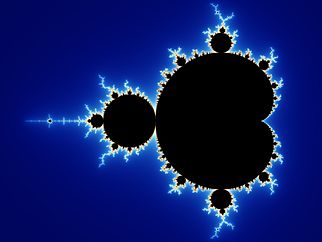
The essence of fractal geometry lies in recursive iteration. What’s that? It’s just a self-referring loop. Let’s start with a simple equation: \(f(x)=2x+1\)
Let x=0 and plug it in, and you’ll get a 1:
\(f(0)=2(0)+1=1\)
(Now, take that 1 and plug it back into the same equation)
\(f(1)=2(1)+1=2\) (Then, take this 2 and do the same thing)
\(f(2)=2(2)+1=5\)
\(f(5)=2(5)+1=11\)
\(f(11)=2(11)+1=23\)
And so forth. You can keep doing this forever, and notice how this list of results (0,1,2,5,11,…) will tend towards infinity (This isn’t always the case)
The mother of all fractals, the Mandelbrot Set is defined by this deceptively simple equation: \(f(z)=z^2+c\) where c is some fixed constant. If you do the same procedure above, you’ll get a series of numbers. eg: Let c=5, and let’s start with z=0:
\(f(0)=0^2+5=5\)
\(f(5)=5^2+5=30\)
\(f(30)=30^2+5=905\)
At IBM, Benoit Mandelbrot used a complex number (a+bi) for that constant. For example, let’s use \(c=1+i\), as he did in his 1980 Scientific American article introducing fractals:
\(f(0)=0^2+(1+i)=1+i\)
\(f(1+i)=(1+i)^2+(1+i)=(1+i)(1+i)+(1+i)=(1+2i+i^2)+(1+i)=2i+(1+i)=1+3i\)
\(f(1+3i)=(1+3i)^2+(1+i)=(1+3i)(1+3i)+(1+i)=(1+6i+9i^2)+(1+i)=6i-8+(1+i)=-7+7i\)
…and so on. For the Mandelbrot set, the calculation is iterated until it’s clear whether the result is tending towards 0 or infinity. Based on this result, for every complex number, you plot a point on the complex plane either black or white. (Or, it is colored based on how fast it tends towards infinity.) For example, 1+i tends towards infinity when plugged into this equation, so a black point is plotted for 1+i on the complex plane. This process was then repeated for every complex number, and was only possible because of the advent of modern computers. Every single complex number gets a point (eg: .234234234 + .324325423i) The result is the deeply infinite, self-referential image you see above. The image is much more complex than it appears. For example, if you zoom in to a certain section, you will see the entire image repeat within itself, and then repeat within that zoom! I can’t do it justice here, so if you want to learn how this Math models real life phenomena & situations, these 2 videos are a great primer for a layman: